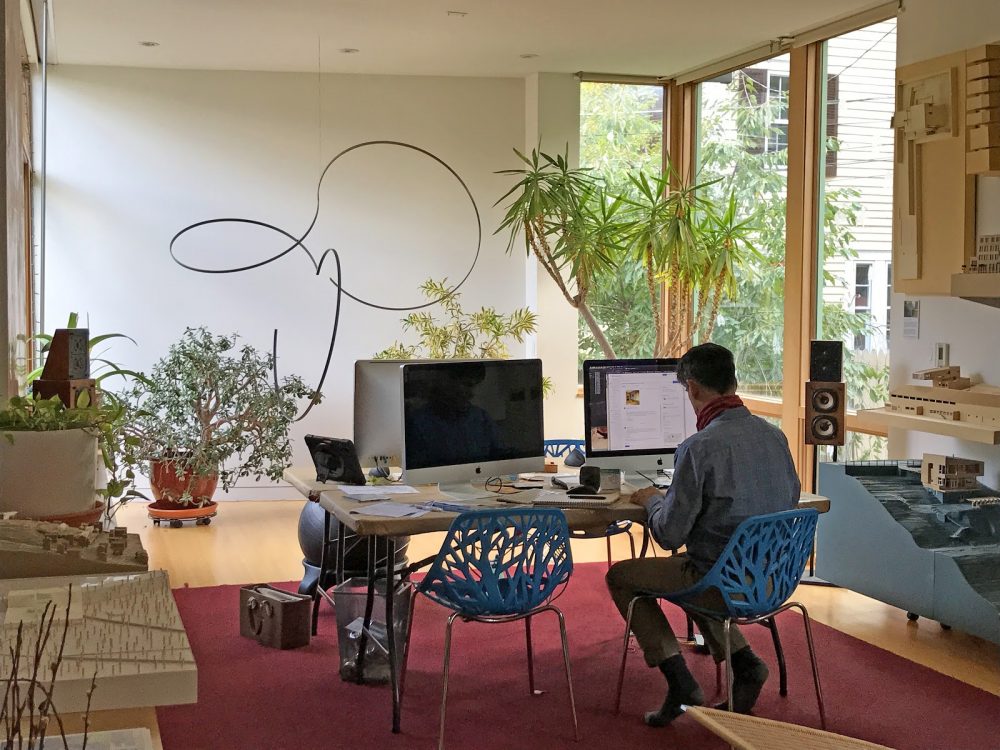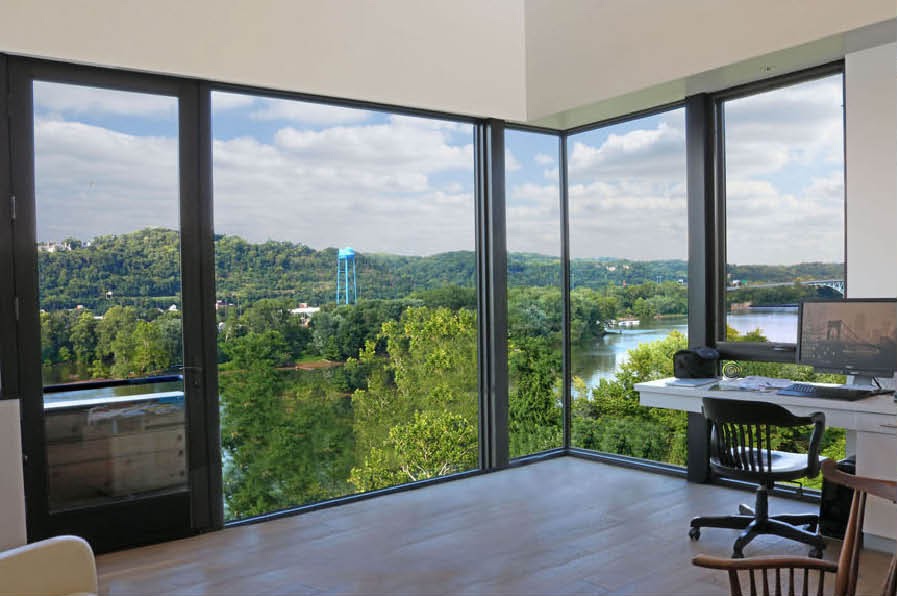Fisher ARCHitecture’s Bea Spolidoro shares three key lessons learned that have shaped our work experience during our time working from home this past year.

With three months to go before we leave 2020 behind, we are all trying to find lessons learned, if any. Among the trends that have emerged during the pandemic, working from home has been one of the most overwhelming. For the four out of ten Americans that can work from home, there was very little time to get ready. After almost seven months of “WFH”, it is time to address what happened and how we can improve our work experience in general.
According to JLL research, global office leasing volumes went down by 59 percent in the second quarter of 2020. Many tech companies are trying to sublet their offices while they evaluate dropping them altogether or not. Employers are allowing their teams to work from home, still wondering how productive they really are. Employees are divided by the hard-core WFH enthusiasts and those that will never recover from homeschooling their kids. There is a lot to unpack and we decided to start our research by creating an 11 questions survey on the impact of remote working on our daily routine. A total of 113 answers were collected between Europe and the USA, across all genders.
In March 2020 many office workers suddenly packed, transferred and then reassembled their work desks at home. Fifty-four percent of the respondents to the survey said they did not have a dedicated space to work from home when the pandemic started. More than half of the workforce had to get creative quickly. A third of the people who took the survey started working from their living room, followed closely by those working from the bedroom and the dining room. One fifth of respondents work from their kitchen. While memes about working from closets or on iron boards flourish, there is actually very little to laugh about.
FIRST DAY AT WORK (FROM HOME)
The perfect WFH layout comes in different sizes. If a private office is not an option, one could possibly find a portion of an existing room with enough space for a table and an office chair. It would be best to have a dedicated desk that is used only for working, even if small. Twenty-four percent of respondents to the survey said they have to dismantle their work environment at the end of the day, making room for other functions, and 11 percent said that was their biggest space-related challenge. The dining or kitchen table, in particular, should be kept free of work-related stuff and actually be used to promote diversity in the daily routine. This would promote mindful eating, keeping people away from the PC and reducing the risk of overeating while distracted by emails etc. (COVID-19 aside, the WELL Building Standard recommends offices should be able to accommodate at least 25 percent of the workforce at once in a dedicated dining room in order to prevent accidental overeating).
Depending on your job and how much paper you handle at once, you may need a bigger set up, maybe one with an L-shape configuration and more than one pc screen. Consider looking for useful additions for your WFH setup in your basement: Many people may find unused family furniture there. Another option is to rethink any shelving in your room: you could make room for a work surface area and maybe you could even create a sit-stand desk solution.
A COMFORTABLE SET UP
Ergonomics are very important whether one is working from home or not. For seven percent of the respondents, poor ergonomics and an inefficient set up are the biggest space-related challenges of WFH. Finding a chair that suits you is number one priority, whether you prefer a traditional task chair, a yoga ball on wheel, or dynamic furniture. A sit-stand solution can also improve your fitness, since it has been proved that we can burn almost twice the calories standing versus sitting down. You may have heard that the best position for office ergonomics “is your next position”. This means that even the most ergonomic chair may fail you at some point if you don’t move enough. Wobbly stools are flourishing in the furniture world, together with treadmill and bike desks. You can find also progressive furniture promoting the astronaut position for an almost gravity-free experience…
Toni Dallier, Principal at Franklin Integrated Interiors in the Strip District, said that some furniture manufacturers are working directly with major companies. High-profile tech and food companies are giving their employees a stipend to be spent on an appropriate WFH set up. In Pittsburgh, Franklin is offering flexible furniture combos that can fit the needs of any company interested in supporting remote working for their teams.
LIGHTING CONSIDERATIONS
Proper lighting and glare control are critical to a positive work environment. If you are exposed to a lot of ‘blue light’ and have to stare at a computer screen for long hours, you should know the 20-20-20 rule. Basically, every 20 minutes spent using a screen, you should try to look away at something that is 20 feet away from you for a total of 20 seconds.
In regards to natural light, there are important considerations one should keep in mind. After identifying a potential WFH area with enough desk space and access to power, one should consider how much natural light does the area have. If it is possible to have access to a window that would help against feeling less isolated and to have a sense of the day passing. It is important to support a healthy circadian rhythm by allowing our body to follow the daylight changing. A skylight would also be good, in particular if it lets indirect light in (direct light can be harsh and create glare in the room).

MANAGING ACOUSTICS
Still, creating the right working conditions at home is not easy when sharing the space with partners or family (61 percent of respondents) it is particularly challenging. We collected many comments about the stress of having to divide the space with family members from 0 to 99 and for the lack of acoustic privacy.
If there are no dust allergies concerns and the WFH is situated on a hard floor, one could consider adding carpeting to the area. This can partially help the sound control. Working from an area with tall ceilings, maybe open to a double-height space, can also be an acoustic challenge. Although a bit invasive, one can invest in some movable sound absorption screens, or maybe even in sound-proof ceiling or wall “clouds”. Depending on your home style, these ceiling clouds may or may not fit the overall aesthetics, but there are many options on the market worth exploring. A basic sound-absorption wall pad can also look a bit cold, although there are many artistic installations-like options as well. Interestingly enough, the majority of respondents profess they were working from an open space at their office before the pandemic and they did not have acoustic privacy even then. Open offices have acoustics challenges but, for some, working from home is even worse. This brings us to the first lessons learned from working from home:
At work or at home, what we really need is focus time and a quality workflow.
The survey has also revealed that the biggest space-related challenge of working from home is feeling isolated (28 percent)! And, in terms of time-related challenges, number one is working too much (42 percent) because their daily routine has no structure anymore. This brings us to the second lesson learned:
We don’t really want to be alone: We just want the flexibility of being able to selectively connect with others
A WHOLE NEW WORK EXPERIENCE?
A combined 38 percent of survey takers feel less efficient at home than at work, either because they are constantly interrupted or because they don’t have the right tools at hand. Having to share the space with family is also a main space-related concern, followed by not having enough space at all. Truthfully, 13 percent of respondents don’t have any issues and simply love working from home!

The last question of the survey asked if, setting aside COVID-related health concerns, people preferred working from home or from the office. The result wasn’t surprising, revealing the complexity and volatility of the subject. Thirty-seven percent of respondents would like to remain at home, 32 percent would prefer to go back to the office, and 31 percent would like a mix of both (with many indicating a 50/50 home/office proportion). This is quite in line with the findings of Global Workplace Analytics (GWA) which estimated that 25 to 30 percent of the workforce will be working-from-home multiple days a week by the end of 2021.
Many companies are planning to reopen on site but with less density. Toni Dallier says that at Franklin they are already doing work shifts at 50 percent capacity, although they haven’t been able to plan yet how to bring all people back. She confirms that many of their clients prefer a mix of working from home and from the office. She also stresses how the office environment is important for building a positive office culture. Eating together, for example, is still very popular. Now, however, a new priority is allowing coworkers to spread out as much as possible. Of course, productivity is a top priority for every employer. The challenge, Toni says, is to get people’s time and attention while making them feel comfortable and safe. So, here is a final lesson learned from 2020:
Productivity is not directly proportional to the time spent in the office
We all have good days and bad days – when we “get lost in a glass of water” (Italian proverb). It can happen whether at work or at home and sometimes we just have to take a walk, maybe even call it a day. Taking breaks is important. Being able to work from home gave people the hope of being more free to take a refreshing pause – maybe fitting in a 10 minute yoga session – and to work in a more flexible way. Forty-two percent of respondents indicated that too much freedom can also be bad. We need boundaries, physical and psychological, that allow us to work in a more thoughtful way.
In general, we can think of any work environment as a climate zone where your particular workstation can be considered a sort of microclimate. As in real life, it is your microclimate that impacts you on a daily basis. Companies will have to optimize everyone’s work environment while making sure that every employee has a suitable microclimate. Depending on each employee’s personal situation and preferences, companies will have to make sure that they give their workers the right space to focus and be productive, based on the design considerations outlined above.
Ultimately, it doesn’t matter where we will be working from in 2021 and beyond. After spending so much time by ourselves, hopefully the biggest silver lining of 2020 is that by now we all know a bit more about ourselves and how we prefer to work.

OTHER REFERENCES:
- https://commons.wikimedia.org/wiki/File:Vincenzo_Catena_-_Saint_Jerome_in_his_Study_-_Google_Art_Project.jpg
- https://www.exoplatform.com/blog/2020/01/08/the-history-of-office-design-from-home-offices-to-remote-working/
- https://www.cnbc.com/2020/05/27/so-your-company-has-said-you-can-work-from-home-forevernow-what.html
- https://www.fastcompany.com/90368542/more-people-are-working-remotely-and-its-transforming-office-design
- https://www.nytimes.com/2020/08/20/style/office-culture.html
- https://www.nytimes.com/2020/08/20/style/working-from-home.html
- https://www.nytimes.com/2020/06/29/technology/working-from-home-failure.html

